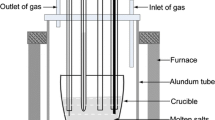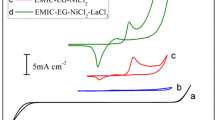Abstract
A highly stable solvate ionic liquid comprising a 2:1 (mol/mol) mixture of ethylene carbonate (EC) and AlCl3 was used for near room-temperature electrochemical codeposition of an Al-Nd alloy using chlorides as precursors. This liquid is low-cost, easy to prepare, and has high electrochemical stability. The ionic structure was analyzed by 27Al nuclear magnetic resonance; Raman spectroscopy and the dissolution phenomenon was studied by ultraviolet-visible spectroscopy. The dissolution mechanism of NdCl3 in this solvate ionic liquid was derived as 3[AlCl2(EC)n]+ + 2NdCl3 ⇆ 2Nd(III) + 3[AlCl4]− + 3nEC. Cyclic voltammetry was used to explore the electrochemical behavior of Nd- and Al-containing species, revealing that the reduction of Al and Nd are both one-step electron-gaining processes. X-ray diffraction confirmed that an Al-Nd alloy can be obtained in the form of thermally stable Al2Nd by potentiostatic electrolysis at high cathode overpotential (− 3.5 V vs. Al). Although the deposited alloy layer is not dense, Al-containing solvate ILs have immense potential in green electrometallurgy because of their higher tunability and similar properties to ILs.









Similar content being viewed by others
References
Song X, Zhang J, Yue M, Li E, Zeng H, Lu N, Zhou M, Zuo T (2006) Technique for preparing ultrafine nanocrystalline bulk material of pure rare-earth metals. Adv Mater 18(9):1210–1215
Kanna RR, Sakthipandi K, Maraikkayar SMSMA, Lenin N, Sivabharathy M (2018) Doping effect of rare-earth (lanthanum, neodymium and gadolinium) ions on structural, optical, dielectric and magnetic properties of copper nanoferrites. J Rare Earths 36(12):1299–1309
Su M, Zhang J, Feng Y, Bai Y, Wang W, Zhang Z, Jiang F (2017) Al-Nd intermetallic phase stability and its effects on mechanical properties and corrosion resistance of HPDC Mg-4Al-4Nd-0.2Mn alloy. J Alloys Compd 691:634–643
Cao ZJ, Kong G, Che CS, Wang YQ, Peng HT (2017) Experimental investigation of eutectic point in Al-rich Al-La, Al-Ce, Al-Pr and Al-Nd systems. J Rare Earths 35(10):1022–1028
Gu Y, Liu J, Qu S, Deng Y, Han X, Hu W, Zhong C (2017) Electrodeposition of alloys and compounds from high-temperature molten salts. J Alloys Compd 690:228–238
Liu F, Deng Y, Han X, Hu W, Zhong C (2016) Electrodeposition of metals and alloys from ionic liquids. J Alloys Compd 654:163–170
Abbott AP, Mckenzie KJ (2006) Application of ionic liquids to the electrodeposition of metals. Phys Chem Chem Phys 8(37):4265–4279
Lisenkov A, Zheludkevich ML, Ferreira MGS (2010) Active protective Al-Ce alloy coating electrodeposited from ionic liquid. Electrochem Commun 12(6):729–732
Bourbos E, Giannopoulou I, Karantonis A, Paspaliaris I, Panias D (2018) Reduction of light rare earths and a proposed process for Nd electrorecovery based on ionic liquids. J Sustain Metall 4(3):395–406
Shen D, Akolkar R (2017) Electrodeposition of neodymium from NdCl3-containing eutectic LiCl-KCl melts investigated using voltammetry and diffusion-reaction modeling. J Electrochem Soc 164(8):H5292–H5298
Hua ZS, Liu H, Wang J, He J, Xiao SJ, Xiao YP, Yang YX (2017) Electrochemical behavior of neodymium and formation of Mg-Nd alloys in molten chlorides. ACS Sustain Chem Eng 5(9):8089–8096
Tang H, Pesic B (2015) Electrochemistry and the mechanisms of nucleation and growth of neodymium during electroreduction from LiCl–KCl eutectic salts on Mo substrate. J Nucl Mater 458:37–44
Liu K, Liu YL, Chai ZF, Shi WQ (2017) Evaluation of the electroextractions of Ce and Nd from LiCl-KCl molten salt using liquid Ga electrode. J Electrochem Soc 164(4):D169–D178
Simka W, Puszczyk D, Nawrat G (2009) Electrodeposition of metals from non-aqueous solutions. Electrochim Acta 54(23):5307–5319
Welton T (2018) Ionic liquids: a brief history. Biophys Rev Lett 10(3):691–706
Hallett JP, Welton T (2011) Room-temperature ionic liquids: solvents for synthesis and catalysis. Chem Rev 111(5):3508–3576
Haarberg GM (2018) Challenges for electrochemical research in molten salts and ionic liquids. Electrochemistry 86(2):19
Chou LH, Hussey CL (2014) An electrochemical and spectroscopic study of Nd (III) and Pr (III) coordination in the 1-Butyl-1-methylpyrrolidinium bis (trifluoromethylsulfonyl) imide ionic liquid containing chloride ion. Inorg Chem 53(11):5750–5758
Bagria P, Luo H, Popovsa I, Thapaliyac BP, Dehaudta J, Dai S (2018) Trimethyl phosphate based neutral ligand room temperature ionic liquids for electrodeposition of rare earth elements. Electrochem Commun 96:88–92
Kondo H, Matsumiya M, Tsunashima K, Kodama S (2012) Attempts to the electrodeposition of Nd from ionic liquids at elevated temperatures. Electrochim Acta 66:313–319
Ota H, Matsumiya M, Sasaya N, Nishihata K, Tsunashima K (2016) Investigation of electrodeposition behavior for Nd (III) in [P2225][TFSA] ionic liquid by EQCM methods with elevated temperatures. Electrochim Acta 222:20–26
Matsumiya M, Mai I, Kazama R, Kawakami S (2014) Electrochemical analyses of diffusion behaviors and nucleation mechanisms for neodymium complexes in [DEME][TFSA] ionic liquid. Electrochim Acta 146:371–377
Smith EL, Abbott AP, Ryder KS (2014) Deep eutectic solvents (DESs) and their applications. Chem Rev 114(21):11060–11082
Abbott AP, Boothby D, Capper G, Davies DL, Rasheed RK (2004) Deep eutectic solvents formed between choline chloride and carboxylic acids: versatile alternatives to ionic liquids. J Am Chem Soc 126(29):9142–9147
Coleman F, Srinivasan G, Swadźba-Kwaśny M (2013) Liquid coordination complexes formed by the heterolytic cleavage of metal halides. Angew Chem Int Ed 52(48):12582–12586
Hogg JM, Coleman F, Ferrer-Ugalde A, Atkins MP, Swadźba-Kwaśny M (2015) Liquid coordination complexes: a new class of Lewis acids as safer alternatives to BF3 in synthesis of polyalphaolefins. Green Chem 17(3):1831–1841
Abbott AP, Harris RC, Hsieh YT, Ryder KS, Sun IW (2014) Aluminium electrodeposition under ambient conditions. Phys Chem Chem Phys 16(28):14675–14681
Abbott AP, Capper G, Davies DL (2006) Solubility of metal oxides in deep eutectic solvents based on choline chloride. J Chem Eng Data 51(4):1280–1282
Fang Y, Yoshii K, Jiang X, Sun XG, Tsuda T, Mehio N, Dai S (2015) An AlCl3 based ionic liquid with a neutral substituted pyridine ligand for electrochemical deposition of aluminum. Electrochim Acta 160:82–88
Fang Y, Jiang X, Sun XG, Dai S (2015) New ionic liquids based on the complexation of dipropyl sulfide and AlCl3 for electrodeposition of aluminum. Chem Commun 51(68):13286–13289
Abood HM, Abbott AP, Ballantyne AD, Ryder KS (2011) Do all ionic liquids need organic cations? Characterisation of [AlCl2·nAmide]+ AlCl4 − and comparison with imidazolium based systems. Chem Commun 47(12):3523–3525
Li M, Gao B, Liu C, Chen W, Wang Z, Shi Z, Hu X (2017) AlCl3/amide ionic liquids for electrodeposition of aluminum. J Solid State Electrochem 21(2):469–476
Abedin SZE (2012) Electrochemical behavior of aluminum and some of its alloys in chloroaluminate ionic liquids: electrolytic extraction and electrorefining. J Solid State Electrochem 16(2):775–783
Zhang BG, Shi ZN, Shen LL, Liu AM, Xu JL, Hu XW (2018) Electrodeposition of Al, Al-Li alloy, and Li from an Al-containing solvate ionic liquid under ambient conditions. J Electrochem Soc 165(9):D321–D327
Zhang BG, Yao Y, Shi ZN, Xu JL, Wang ZW (2018) Direct electrochemical deposition of lithium from lithium oxide in a highly stable aluminium-containing solvate ionic liquid. ChemElectroChem 5(22):3368–3372
Hu P, Zhang R, Meng X, Liu H, Xu C, Liu Z (2016) Structural and spectroscopic characterizations of amide-AlCl3-based ionic liquid analogues. Inorg Chem 55(5):2374–2380
Tsuda T, Nohira T, Ito Y (2001) Electrodeposition of lanthanum in lanthanum chloride saturated AlCl3–1-ethyl-3-methylimidazolium chloride molten salts. Electrochim Acta 46(12):1891–1897
Brown LC, Hogg JM, Swadźba-Kwaśny M (2017) Lewis acidic ionic liquids. Top Curr Chem 375(5):78–85
Li JF, Tu JG, Jiao HD, Wang C, Jiao SQ (2017) Ternary AlCl3-urea-[EMIm] Cl ionic liquid electrolyte for rechargeable aluminum-ion batteries. J Electrochem Soc 164(13):A3093–A3100
Zhang C, Yu D, Zhang L, Wang X, Zhao Y, Zhang X, Yu G (2017) A sustainable redox-flow battery with an aluminum-based deep-eutectic-solvent anolyte. Angew Chem Int Ed 56(26):7454–7459
Mutlu RN, Yazıcı B (2019) Copper-deposited aluminum anode for aluminum-air battery. J Solid State Electrochem 23(2):529–541
Funding
This work was financially supported by the National Key R&D Program of China (No. 2017YFC0805100), National Natural Science Foundation of China (No. 51574071), and the Fundamental Research Funds for the Central Universities (N172502003).
Author information
Authors and Affiliations
Corresponding author
Additional information
Publisher’s note
Springer Nature remains neutral with regard to jurisdictional claims in published maps and institutional affiliations.
Rights and permissions
About this article
Cite this article
Zhang, B., Shi, Z., Shen, L. et al. Low-temperature electrochemical codeposition of aluminum-neodymium alloy in a highly stable solvate ionic liquid. J Solid State Electrochem 23, 1903–1909 (2019). https://doi.org/10.1007/s10008-019-04293-7
Received:
Revised:
Accepted:
Published:
Issue Date:
DOI: https://doi.org/10.1007/s10008-019-04293-7




